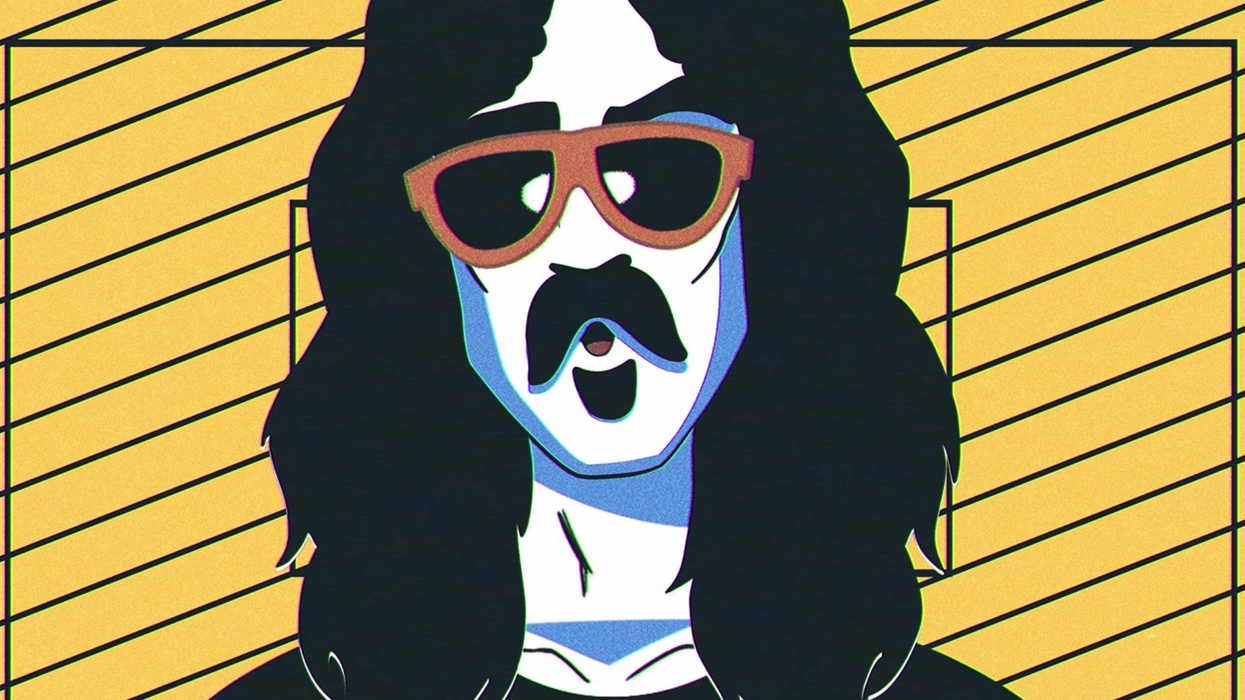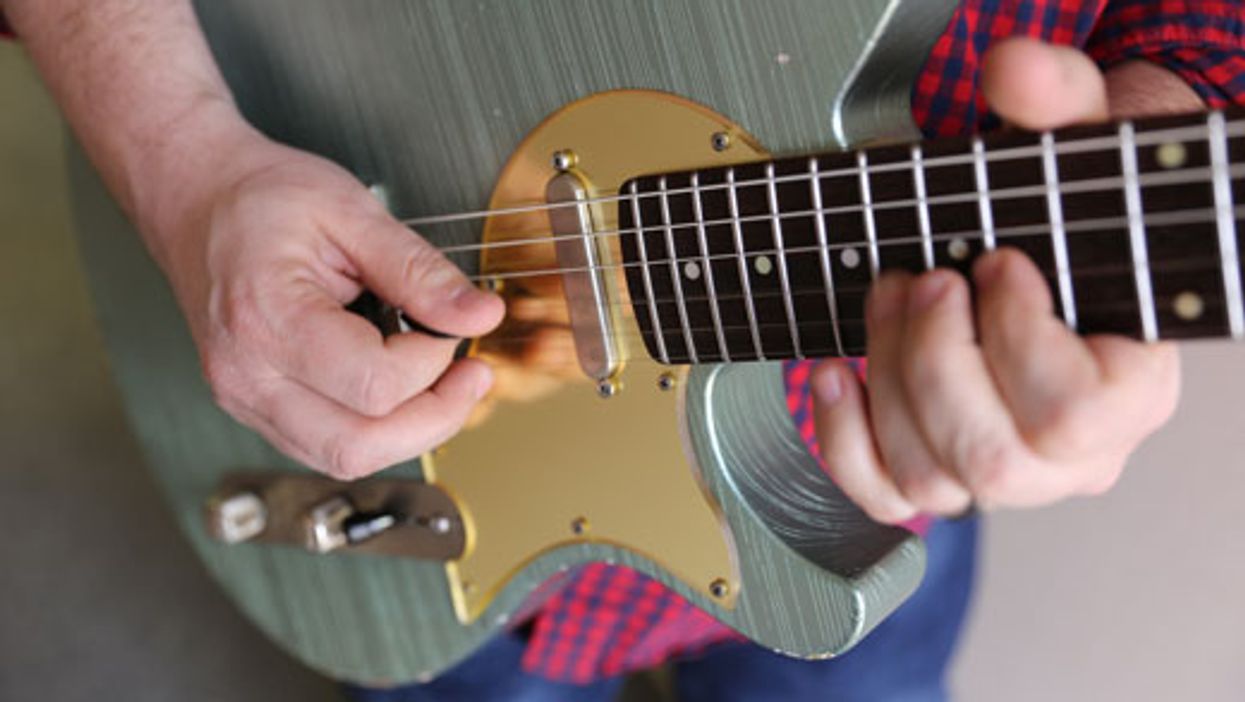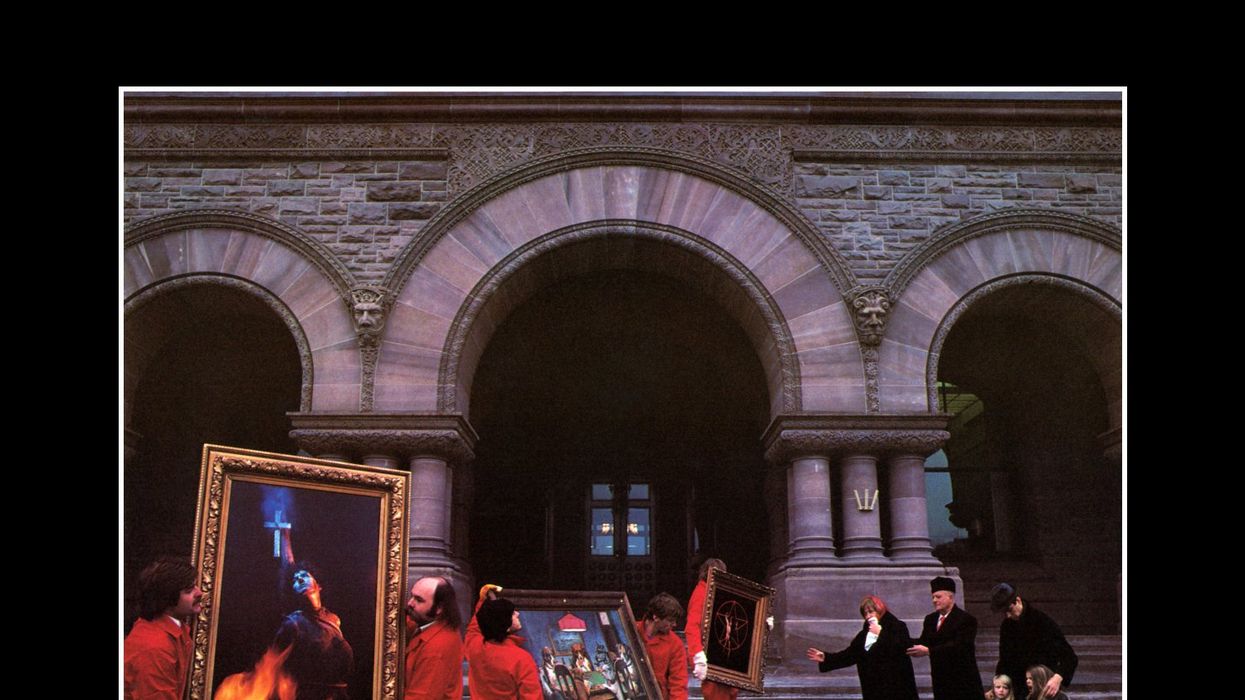This lesson simplifies Zappa’s ideas to make them more approachable and playable. Almost all of the examples begin on the downbeat, making them a bit stiff compared to Frank’s unpredictability, but easier to comprehend. I also repeated them several times, which Frank rarely did unless stating a theme or melody. This is the irony of Frank’s compositions versus his solos: The composed pieces are exacting and played meticulously, the solos are loose and performed with wild abandon.
That Ol’ Dorian, Santana, Zappa Thing
Before we get to the licks, we’re obliged to discuss the chord progressions and audio examples used in this lesson. Most of the time Frank would solo over a two-chord vamp and occasionally over one chord, or a one-note pedal. Check out “Cosmik Debris” below for an “occasional” 12-bar framework.
In the first few examples, the Dm7 to G7 chord progression implies the key of D Dorian (D–E–F–G–A–B–C), which is minor, yet more laidback than Aeolian. This is a mode Carlos Santana frequently solos in, so Zappa’s “Variations on the Carlos Santana Secret Chord Progression” is a pretty accurate name. My example’s vamp is based on Zappa’s “Son of Mr. Green Genes” and “Po-Jama People,” slightly slower.
Ex. 1 is common in Frank’s playing. Here, I use pull-offs to open-strings with a combination of triplet-based rhythms. You should also hear that I am subtly moving a wah-wah pedal. Nothing dramatic, just enough to highlight certain frequencies. A touch of wah is a key element of Zappa’s tone throughout his career.
Variation is key when dealing with repeated motifs. In Ex. 2 I moved the idea from Ex. 1 down an octave and tweaked the rhythm a bit. There is a triplet followed by four 16th-notes, then another triplet followed by two more 16th-notes. This grouping of different rhythmic figures is textbook Zappa.
Tremolo picking is a great technique that you can use to build energy and tension, while also adding a new melodic texture. In Ex. 3 I take a stab at something that Frank might play on the amazing live album, The Best Band You Never Heard in Your Life.
One of Zappa’s most adventurous solos is on the title track of the Apostrophe (') album. In Ex. 4 you can see how I emulated the off-kilter rhythms and combined them with open strings.
As you can tell by now, mixing rhythms is a hallmark of Zappa’s style. In Ex. 5 I leaned on both 16th-note and eighth-note triplets to give the lick an uneasy, frantic feeling. (Don’t forget to tremolo pick on beat 2 of the last measure.)
Ex. 6 is one of the most challenging licks in this solo. It features a combination of rhythms as well as tremolo picking. Use the slow-down feature to get this one right.
Ex. 7 introduces Zappa’s two-handed pick-tapping move. Several years before Eddie Van Halen’s two-handed tapping changed the world of guitar, Zappa was performing his own version of the technique. He would tap the frets with the round side of his pick, typically staying on one note for an extended period of time, while holding down a second note, or trilling (alternating between two notes) with his left hand. Full disclosure, I had to use a considerable amount of compression and gain to recreate this sound.
Finally, you can hear all these phrases in context in the complete solo below.
Two-Chord Mixolydian Vamp
These next examples emulate the solo section of what many consider to be one of the exemplary Zappa songs, “Inca Roads.” I might suggest that this could be the quintessential Zappa solo except for the fact that there are many versions of Frank improvising over this two-chord, IV–V Mixolydian vamp (this example features the chords D to E in the key of A major thus E Mixolydian). Note: I hate to contradict the master, as Zappa referred to this solo as being in the Lydian mode, but, at the risk of nitpicking, I hear this solo resolving to the V chord, thus Mixolydian, not Lydian.
In addition to several officially released versions of “Inca Roads,” this vamp, out of context, constitutes all three variations of “Shut Up ’n Play Yer Guitar” as well as “Gee, I Like Your Pants,” “A Cold Dark Matter,” and “Systems of Edges.” A similar vamp is also used in “Son of Orange County.” It might not be the definitive Zappa solo but it’s the definitive Zappa vamp. Let’s see what we can do with it.
Ex. 8 is another open-string lick, with a fast, grace-note slide that’s similar to the opening lick of “Son of Orange County” from Roxy & Elsewhere.
Just like we did in the Dorian examples, I took the motif in Ex. 8 and moved it up an octave for Ex. 9.
Ex. 10 is another pick-tapping lick, with more movement than the first one we played. You can hear this influence in Joe Satriani’s playing.
Ex. 11 features more unusual rhythmic groupings, alternating eighth-notes and eighth-note triplets. Though relatively manageable to play on their own, this combination of rhythms can be tricky to perform if you’re not used to interspersing them. One thought to keep in mind while working on these seemingly uncommon rhythms (I’m paraphrasing Zappa here): People don’t speak in 4/4 time or in straight eighths. The rhythms of human speech, in one way sound weird, but they also sound totally natural. If you keep this in mind in general, your solos could become more rhythmically imaginative.
One of the most intriguing parts of Zappa’s playing and musicianship is the use of dynamics. Rather than solo at a continuous, steady volume, he would play from very quiet to extremely loud and all points in between. He would do this both throughout his solos and also in short, discreet phrases such as Ex. 12.
Ex. 13 is our first example of low-string playing. Many players find this range too muddy for solos, but Frank spent considerable time improvising at the low end of his register.
Lydian Arpeggio Vamp
This final set of examples exhibit three different Zappa tendencies:
- Odd-metered progressions. Frank composed too many of these to count them all. This example is in 7/4.
- An arpeggio vamp. You can hear this in “Treacherous Cretins,” “The Deathless Horsie,” and “Watermelon in Easter Hay.”
- The Lydian mode. As mentioned earlier, the Mixolydian sound emphasizes the V chord in a IV–V progression.
The Lydian sound conversely emphasizes the IV or the 4th degree of the scale in the bass, as demonstrated in Ex. 14. These two chords, Add9 and Badd11/A are the IV and the V in the key of E, however, as the bass continues to drone the note A throughout, the tonal center of A Lydian is firmly established.
Ex. 15 provides more open-strings and bursts of notes. This particular lick shows how you can move around the fretboard, sustaining certain notes over others, all the while continuing to use the same phrasing and open-string ideas.
Ex. 16 is similar to a phrase heard in “Watermelon in Easter Hay,” with another dynamic, tremolo note to finish the line.
Ex. 17 is harder than it looks. It appears to run straight up the minor pentatonic scale at the 9th fret, but the double-picked notes, the added A (creating a hexatonic scale), and the unusual rhythmic groupings produce an unexpected challenge.
Ex. 18 has a combination of numerous approaches we’ve already covered: low-note playing, open-string pull-offs, and quintuplets…not to mention the slides to end.
Ex. 19 proves that Zappa wasn’t one to neglect classic blues-rock cliches. This example is like countless pentatonic blues licks yet with the added dimension of starting in an unexpected place, the second note of an eighth-note triplet figure, followed by unusual rhythmic groupings. For as Zappa-esque as this lick is, it would not be unusual to hear Jimi Hendrix to play such a phrase.
Zappa’s Rhythm Section
To faithfully imitate Zappa, you need a world-class rhythm section. Throughout his career, Frank’s various band lineups included outstanding bass players and drummers. So, while a drum loop and rudimentary vamp might serve the purposes of practice and a lesson, to recreate the Zappa sound, find yourself a like-minded bass player and drummer who are as committed to Zappa as you are—it will make all the difference.
Zappa Recommendations for the Newcomer
For those of you that are new to Zappa, here are a list of tracks that highlight his guitar playing within the context of unique songs and instrumental compositions.
“Son of Mr. Green Genes” Hot Rats (1969)
“The Grand Wazoo” The Grand Wazoo (1972)
“I’m the Slime” Over-Nite Sensation (1973)
“Stink Foot,” “Uncle Remus,” “Cosmik Debris” Apostrophe (’) (1974)
“Son of Orange County” Roxy & Elsewhere (1974)
“Inca Roads,” “Po-Jama People” One Size Fits All (1975)
“Black Napkins” Zoot Allures (1976)
“Inca Roads,” “Pygmy Twylyte” You Can’t Do That on Stage Anymore, Vol. 2 (Recorded 1974, Released 1988)
“Watermelon in Easter Hay” Joe’s Garage (1979)
“Heavy Duty Judy,” “Andy,” “Inca Roads,” “Zomby Woof” The Best Band You Never Heard In Your Life (1991)

















